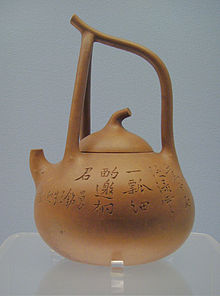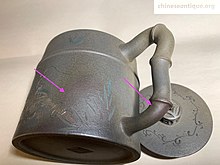Yixing clay teapot
This article needs additional citations for verification. (August 2012) |


Yixing clay teapots (simplified Chinese: 宜兴; traditional Chinese: 宜興; pinyin: Yíxīng; Wade–Giles: I-Hsing), also called Purple Sand (Chinese: 紫砂; pinyin: zǐshā; Wade–Giles: tsu sha), are made from Yixing clay. This traditional style commonly used to brew tea originated in China, dating back to the 15th century, and are made from clay produced near Yixing in the eastern Chinese province of Jiangsu.
History[]
This section needs expansion with: history during the 1000-year period between its origins and the 20th century. You can help by . (January 2013) |
Archaeological excavations reveal that as early as the Song dynasty (10th century) potters near Yixing were using local "zisha" (紫砂 or 紫泥 ; literally, "purple sand/clay") to make utensils that may have functioned as teapots. According to the Ming dynasty author , during the reign of the Zhengde Emperor, a monk from Jinsha Temple (Golden Sand Temple) in Yixing handcrafted a fine quality teapot from local clay. Such teapots soon became popular with the scholarly class, and the fame of Yixing teapots began to spread.
20th century[]
This section needs additional citations for verification. (January 2013) |
Yíxīng teapots are actually made in nearby , also known as Dingshu,[1] on the west side of Lake Tai.[2] Hundreds of teapot shops line the edges of the town's crowded streets and it is a popular tourist destination for many Chinese. While Dīngshān is home to dozens of ceramics factories, Yíxīng Zǐshā Factory Number 1, which opened in 1958,[citation needed] processes a large part of the clay used in the region, produces fine pottery ware, and has a large commercial showroom. In addition to the better known teapots, tea pets, oil and grain jars, flower vases, figurines, glazed tiles, tables, ornamental rocks, and even ornamental waste bins are all manufactured in the community.[citation needed]
Use with tea[]
This section does not cite any sources. (January 2013) |

Yixing teapots are intended for puer, black, and oolong teas. They can also be used for green or white teas; however, the heat retention characteristics of Yixing makes the brewing process extremely difficult; and in such cases, the water must be heated to no greater than 85 °C (185 °F), before pouring into the teapot. A famous characteristic of Yixing teapots are their ability to absorb trace amounts of brewed tea flavors and minerals into the teapot with each brewing. Over time, these accumulate to give each Yixing teapot its own unique interior coating that flavors and colors future brewings. It is for this reason that soap is not recommended for cleaning Yixing teapots, but instead, fresh distilled water and air drying. Many tea connoisseurs will steep only one type of tea in a particular Yixing teapot, so that future brewings of the same type of tea will be optimally enhanced. In contrast, brewing many different types of tea in a Yixing pot is likely to create a coating of mishmashed flavors that muddy the taste of future brewings.
Some Yixing teapots are smaller than their western counterparts as the tea is often brewed using the gongfu style of brewing: shorter steeping durations with smaller amounts of water and smaller teacups (compared to western-style brewing). Traditionally, the tea from the teapot is poured into either a small pitcher, from which it is then poured into a teacup that holds approximately 30 ml or less of liquid, allowing the tea to be quickly and repeatedly ingested before it becomes cooled, or into several teacups for guests.
Price[]
Prices can vary from a couple dozen to thousands of yuan.[3] A pot was auctioned in 2010 for 12.32 million yuan.[4] Generally, the price of Yixing teapots are dependent on such factors such as age, clay, artist, style and production methods. The more expensive pots are shaped by hand using wooden and bamboo tools to manipulate the clay into form, while cheaper Yixing pots are produced by slipcasting.
Tianqing Clay (Chinese: 天青泥; pinyin: tiānqīng ní)[]
The most important part of the teapot is its clay. There are 3 major types of Zisha clays: Purple, Red, and Green. [5] The fourth type Duan is a mix of Purple and Red. The Tianqing clay, a subtype of the Purple clay, has been the most precious and sought-after of all types since the Ming and Qing dynasties. However, it is extremely rare and vanished since late Qing dynasty. Only very recently Yixing teapots of TianQing clay made in the Qing dynasty were reportedly found in the US.[6] Here are its characteristics:
Characteristics of Tianqing Clay Teapots[]
- It vanished in the late Qing dynasty (Be aware of scam if it is made afresh)
- It has a dark liver color after firing.[7]
- It feels and looks very sandy, has extreme permeability and therefore very easy to produce "Zisha Appeal" (patina with semi-transparency).
- It can turn greenish after a period of usage and has a jade-like appearance[8] with astonishing beauty. It is this drastic change of color after Usage not after Firing (all clay teapots change color when fired) that makes it a Tianqing clay.
- It can shows a bizarre effect after firing.
Please note that cobalt blue (Chemical teapot) is NOT TianQing clay.
Comparison of Likely Tianqing Clay Teapots[]
| Picture | Name | Year Made | Main Colors | Feel and look very sandy, extreme permeability | Shiny and Metal like | Can show a bizarre effect after firing |
|---|---|---|---|---|---|---|
 |
Qing Yixing teapot by SHAO Hengyu of Tianqing clay | Qing dynasty | Blue or Dark Grey, or Greenish (after usage or soaked in water for a week) | Yes | Yes | No |
 |
Qing Yixing teapot by YANG Pengnian of Tianqing clay | Qing dynasty (Daoguan reign) | Dark liver | Yes | Yes | No |
 |
Qing Yixing teapt by SHI Jichang of Tianqing clay | Qing dynasty (Kangxi reign) | Green, with multiple purple areas | Yes | Yes | Yes |
 |
Qing Yixing teapot marked Qingquan Meiyu of Tianqing clay | Qing dynasty | Dark liver, plus green for thin areas (after soaked in water for a week) | Not obvious of Sandiness | Yes for green areas | Dark liver color and Green color at the same time |
 |
Qing Yixing teapot marked CHEN Mingyuan of Tianqing clay | Qing dynasty (Kangxi or Yongzheng reign) | Dark liver, plus Blue or Dark Grey, and Green particles | Yes | Yes | Dark liver, plus Blue or Dark Grey, and Green particles at the same time |
References[]
- ^ Introducing Dīngshān from Lonely Planet. Retrieved 11 January 2013.
- ^ Introducing Lake Tai from Lonely Planet. Retrieved 11 January 2013.
- ^ "Antique Yixing Teapots". MingWrecks.com. 17 September 2011. Retrieved 2 August 2012.
- ^ 北京紫砂壶拍卖创出1232万世界纪录(图)_新闻中心_新浪网 (in Chinese). Sina Corp. 9 June 2010. Retrieved 2 August 2012.
- ^ "紫砂壶,几种最常见的泥料详解大全--书画--人民网". art.people.com.cn. Retrieved 12 March 2021.
- ^ Qing Yixing Zisha Teapot of TianQing Clay Found in US 清代天青泥紫砂壶首次被发现. . 2 February 2021. Retrieved 4 February 2021.
- ^ 阳羡茗壶系 by 周高起, Ming dynasty.
- ^ 刘玉林,戴银法 《阳羡茗砂土》,四川美术出版社, 2013:84-88
Further reading[]
| Wikimedia Commons has media related to Yixing ware. |
- K.S. Lo, et al., The Stonewares of Yixing: from the Ming period to the Present Day, (London: 1986, ISBN 0856671819).
- Wain, Peter, "A Taste of Transition: The Teapots of Yixing", Ceramic Review, 153, May/June 1995, pp. 42–45p
- Pan Chunfang, Yixing Pottery: the World of Chinese Tea Culture, (San Francisco, : 2004, ISBN 159265018X).
External links[]
- Yixing Clay Teapot at China Online Museum
- "A Handbook of Chinese Ceramics". The Metropolitan Museum of Art Libraries. OCLC.
- "Zisha Teapots with National Living Treasure Zhou Gui Zhen and Zhu Jian Long". video of hand making a teapot
- Teapots
- Chinese pottery
- Culture in Wuxi
- Yixing
- Stoneware